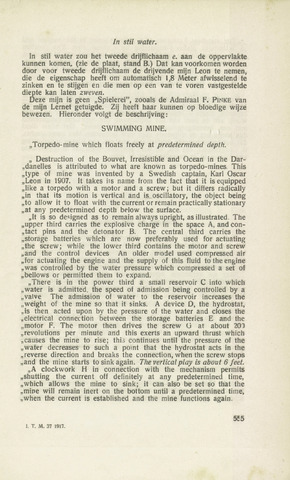In stil water.
In stil water zou het tweede drijflichaam e. aan de oppervlakte
kunnen komen, (zie de plaat, stand B.) Dat kan voorkomen worden
door voor tweede drijflichaam de drijvende mijn Leon te nemen,
die de eigenschap heeft om automatisch 1,8 Meter afwisselend te
zinken en te stijgen en die men op een van te voren vastgestelde
diepte kan laten zweven.
Deze mijn is geen „Spielerei", zooals de Admiraal F. Pinke van
de mijn Lernet getuigde. Zij heeft haar kunnen op bloedige wijze
bewezen. Hieronder volgt de beschrijving:
SWIMMING MINE.
„Torpedo-mine which floats freely at predetermined depth.
Destruction of the Bouvet, Irresistible and Ocean in the Dar
danelles is attributed to what are known as torpedo-mines. This
„type of mine was invented by a Swedish captain, Karl Oscar
„Leon in 1607. It takes iis name from the fact that it is equipped
„like a torpedo with a motor and a screw; but it differs radically
„in that its motion is vertical and is oscillatory, the object being
„to allow it to float with the current or remain practically stationary
„at any predetermined depth below the surface.
„It is so designed as to remain always upright, as illustrated. The
„upper third carries the explosive charge in the space A, and con
tact pins and the detonator B. The central third carries the
„storage batteries which are now preferably used for actuating
„the screw; while the lower third contains the motor and screw
„and the control devices An older model used compressed air
„for actuating the engine and the supply of this fluid to the engine
„was controlled by the water pressure which compressed a set of
„bellows or permitted them to expand.
„There is in the power third a small reservoir C into which
„water is admitted, the speed of admission being controlled by a
„valve The admission of water to the reservoir increases the
„weight of the mine so that it sinks. A device D, the hydrostat,
„is then acted upon by the pressure of the water and closes the
„electrical connection between the storage batteries E and the
„motor F. The motor then drives the screw U at about 201
„revolutions per minute and this exerts an upward thrust which
„causes the mine to rise; this continues until the pressure of the
„water decreases to such a point that the hydrostat acts in the
„reverse direction and breaks the connection, when the screw stops
„and the mine starts to sink again. The vertical play is about 6 feet.
„A clockwork H in connection with the mechanism permits
„shutting the current off definitely at any predetermined time,
„which allows the mine to sink; it can also be set so that the
„mine will remain inert on the bottom until a predetermined time,
„when the current is established and the mine functions again.
5E5
1. T. M. 37 1917.

